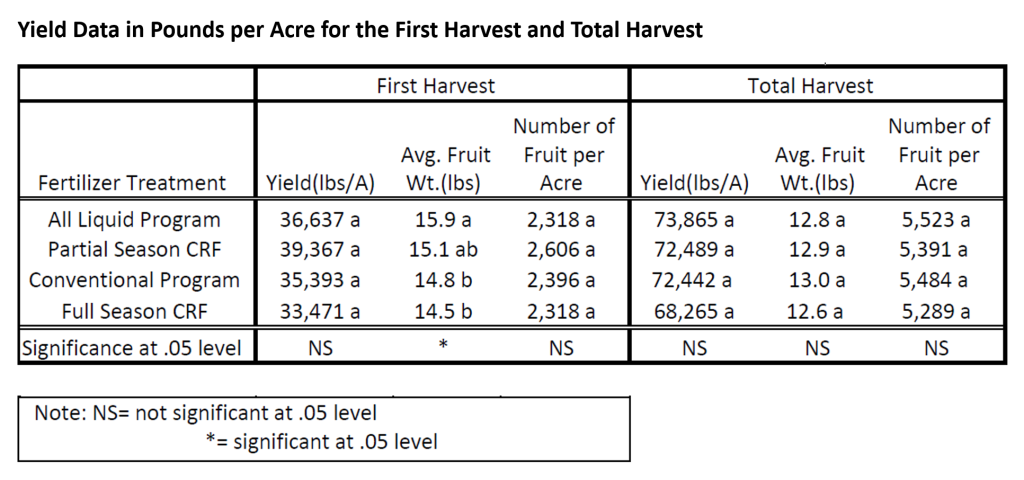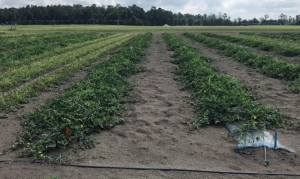Watermelon is a major crop grown in the Suwannee Valley. It accounts for nearly one-third of the total watermelon production in Florida, covering approximately 26,300 acres. The Sunshine State grows about one of every four watermelons produced in the United States each year. This tasty crop represents an $88 million industry for Florida agriculture!
Cultural practices used to grow watermelons have changed in the last 25 to 30 years. North Florida growers transitioned away from planting on bare ground and watering with overhead center pivot irrigation. Now they use more efficient plastic mulch and drip irrigation practices. Growers and supporting agriculturalists are intently focusing on the implementation of best management practices (BMPs). These create the most environmentally and economically sustainable growing operations possible.
Research and Extension Efforts
Spring 2023 was the beginning of a new research trial at the North Florida Research and Education Center (NFREC)-Suwannee Valley:
“Evaluation of Water-Soluble and Controlled Release Fertilizer Sources and Delivery Methods in Watermelon for Yield, Fruit Number and Weight, and Nitrogen and Potassium in Leaf Tissue”
Funding support came from the Florida Watermelon Association, NFREC-Suwannee Valley Staff, and other industry cooperators. The project’s collaborators are Mark Warren, Tatiana Sanchez-Jones, Tyler Pittman, Jay Capasso, Dan Fenneman, Emily Beach, Sudeep Sidhu, Kevin Athearn, Kaleb Kelley, and Avery Kelley.
The group demonstrated the irrigation system automation during a field day event in April. That also included an update on research with paper mulch and successful fertilizer management programs. Approximately 40 people attended the event, including growers, industry professionals, UF/IFAS staff, and other interested parties. Mr. Bob Hochmuth, NFREC-Suwannee Valley assistant center director, also presented the research results at the Florida Watermelon Association’s Annual Convention. About 70 people attended that Grower Educational Session in October.
Objective
The objective of this research was to evaluate nitrogen (N) and potassium (K) management programs comparing controlled release fertilizer (CRF), all liquid fertilizer, and a conventional commercial fertilizer program. All programs were implemented using plastic mulch and a drip irrigation system typically used for watermelons grown in North Florida’s deep sandy soils.
Treatments
This trial included four different fertilizer treatments replicated four times. All treatments received the same total season N (150 lbs/A) and K2O (200 lbs/A) rates. The K2O applications included 50 lbs/A pre-plant applied to all plots from the application of 0-8-13 (N- P2O5 -K2O). The remainder of the fertilizer was applied to each treatment as described below. All nutrients, other than N and K, were applied uniformly to the experimental area before beds were formed. The four fertilizer treatments were:
- “Conventional” – Traditional conventional granular fertilizer (uncoated) with 45 lbs/A of N and K2O in the bed prior to laying plastic mulch and the remainder (105 lbs/A) of N and K2O via fertigation through the drip system.
- “Full Season CRF” – Polymer-coated fertilizer applied to the soil prior to laying plastic mulch for a season-long supply of N and K (150 lbs/A of N and K2O).
- “Partial Season CRF” – Polymer-coated nitrogen and potassium fertilizer with 45 lbs/A of N and K2O applied to the soil prior to laying plastic mulch and the remainder (105 lbs/A) of N and K2O applied via fertigation through the drip system.
- “All Liquid” – Soluble sources of N and K (8-0-8 N-P2O5-K2O) solution were supplied from the beginning of the season, fertigated via drip irrigation (150 lbs/A of N and K2O).
Mid-season view of the trial (click image for larger view):
Results
The results of this trial showed that all four fertilizer treatments performed similarly and maintained a sufficient or high level of leaf tissue N throughout the entire season. However, leaf tissue K concentrations were maintained at or slightly below the recommended range on occasion. Total watermelon yield ranged from 68,265 lbs/acre to 73,865 lbs/acre for all three harvests combined. There were no statistically significant yield differences between the four treatments. The data supported the idea that any of the four fertilizer programs if properly managed with irrigation, can sufficiently meet crop N and K needs and provide similar high yield and fruit size. 
 2
2


